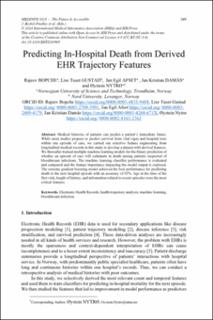| dc.contributor.author | Bopche, Rajeev | |
| dc.contributor.author | Gustad, Lise Tuset | |
| dc.contributor.author | Afset, Jan Egil | |
| dc.contributor.author | Damås, Jan Kristian | |
| dc.contributor.author | Nytrø, Øystein | |
| dc.date.accessioned | 2024-04-19T11:18:19Z | |
| dc.date.available | 2024-04-19T11:18:19Z | |
| dc.date.created | 2023-10-03T10:48:16Z | |
| dc.date.issued | 2024 | |
| dc.identifier.citation | Bopche, R., Gustad, L. T., Afset, J. E., Damås, J. K. & Nytrø, Ø. (2024). Predicting in-hospital death from derived EHR trajectory features. Studies in Health Technology and Informatics, 310, 269-273. doi: | en_US |
| dc.identifier.issn | 1879-8365 | |
| dc.identifier.uri | https://hdl.handle.net/11250/3127423 | |
| dc.description.abstract | Medical histories of patients can provide insight into the immediate future of a patient. While most studies propose to predict survival from vital signs and hospital tests within one episode of care, we carry out selective feature engineering from longitudinal historical medical records in this study to develop a dataset with derived features. We then train multiple machine learning models for the binary prediction whether an episode of care will culminate in death among patients suspected of bloodstream infections. The machine learning classifier performance is evaluated and compared and the feature importance impacting the model output is explored. The findings indicated that the logistic regression model achieved the best performance for predicting death in the next hospital episode with an accuracy of 98% and an almost perfect area under the receiver operating characteristic curve. Exploring the feature importance reveals that time to and severity of the last episode and previous history of sepsis episodes were the most critical features. | en_US |
| dc.language.iso | eng | en_US |
| dc.publisher | IOS Press | en_US |
| dc.relation.ispartof | Studies in health technology and informatics | |
| dc.rights | Navngivelse-Ikkekommersiell 4.0 Internasjonal | * |
| dc.rights.uri | http://creativecommons.org/licenses/by-nc/4.0/deed.no | * |
| dc.title | Predicting in-hospital death from derived EHR trajectory features | en_US |
| dc.type | Peer reviewed | en_US |
| dc.type | Journal article | en_US |
| dc.description.version | publishedVersion | en_US |
| dc.rights.holder | © 2024 International Medical Informatics Association (IMIA) and IOS Press | en_US |
| dc.source.pagenumber | 269-273 | en_US |
| dc.source.volume | 310 | en_US |
| dc.source.journal | Studies in Health Technology and Informatics | en_US |
| dc.identifier.doi | 10.3233/SHTI230969 | |
| dc.identifier.cristin | 2181240 | |

